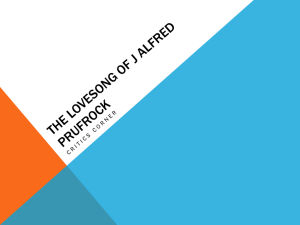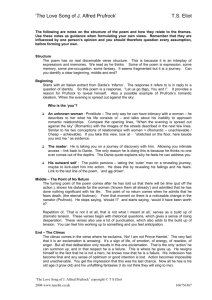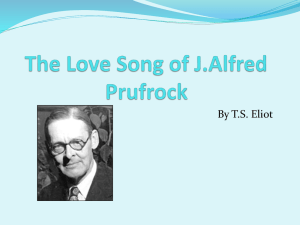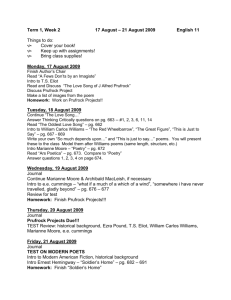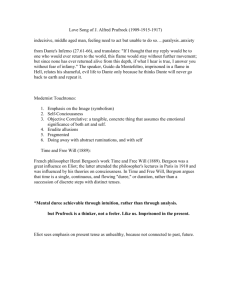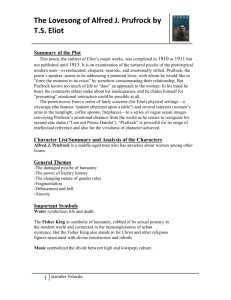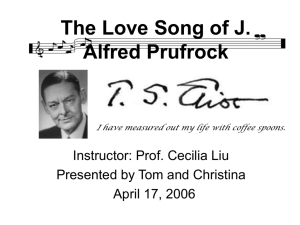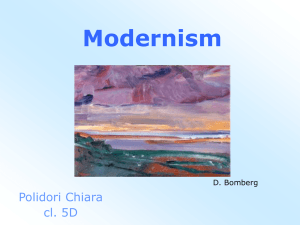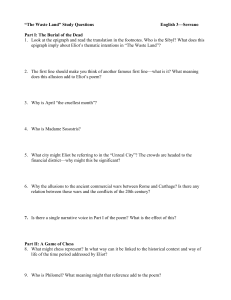ADeMeo - Analysis of - marilenabeltramini.it
advertisement
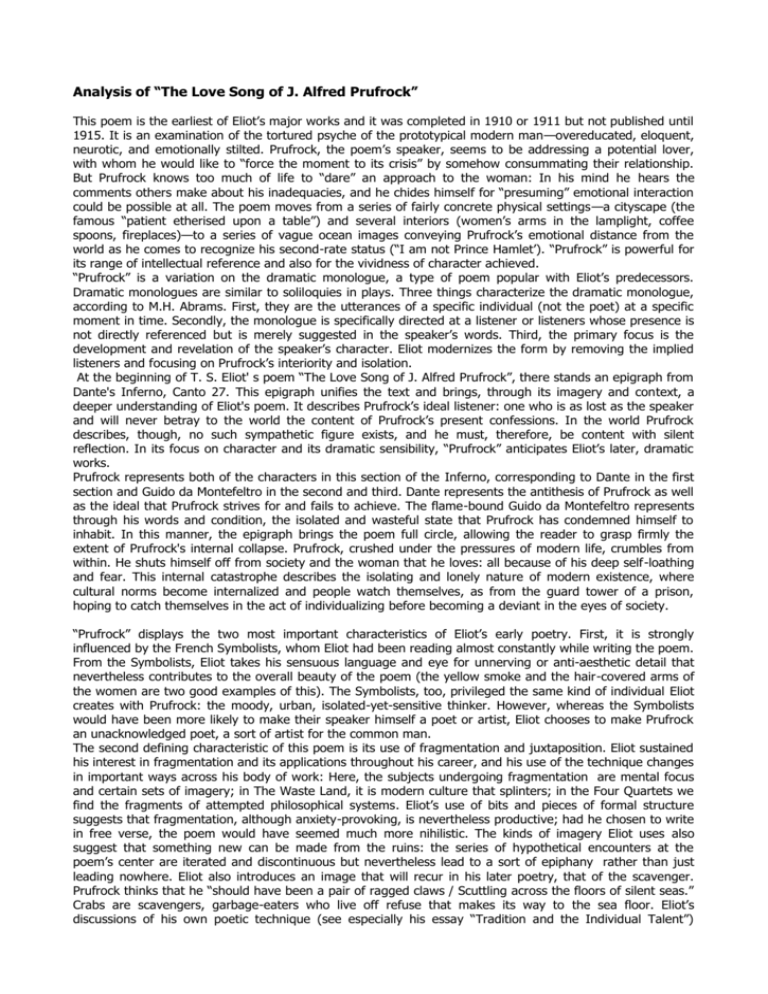
Analysis of “The Love Song of J. Alfred Prufrock” This poem is the earliest of Eliot’s major works and it was completed in 1910 or 1911 but not published until 1915. It is an examination of the tortured psyche of the prototypical modern man—overeducated, eloquent, neurotic, and emotionally stilted. Prufrock, the poem’s speaker, seems to be addressing a potential lover, with whom he would like to “force the moment to its crisis” by somehow consummating their relationship. But Prufrock knows too much of life to “dare” an approach to the woman: In his mind he hears the comments others make about his inadequacies, and he chides himself for “presuming” emotional interaction could be possible at all. The poem moves from a series of fairly concrete physical settings—a cityscape (the famous “patient etherised upon a table”) and several interiors (women’s arms in the lamplight, coffee spoons, fireplaces)—to a series of vague ocean images conveying Prufrock’s emotional distance from the world as he comes to recognize his second-rate status (“I am not Prince Hamlet’). “Prufrock” is powerful for its range of intellectual reference and also for the vividness of character achieved. “Prufrock” is a variation on the dramatic monologue, a type of poem popular with Eliot’s predecessors. Dramatic monologues are similar to soliloquies in plays. Three things characterize the dramatic monologue, according to M.H. Abrams. First, they are the utterances of a specific individual (not the poet) at a specific moment in time. Secondly, the monologue is specifically directed at a listener or listeners whose presence is not directly referenced but is merely suggested in the speaker’s words. Third, the primary focus is the development and revelation of the speaker’s character. Eliot modernizes the form by removing the implied listeners and focusing on Prufrock’s interiority and isolation. At the beginning of T. S. Eliot' s poem “The Love Song of J. Alfred Prufrock”, there stands an epigraph from Dante's Inferno, Canto 27. This epigraph unifies the text and brings, through its imagery and context, a deeper understanding of Eliot's poem. It describes Prufrock’s ideal listener: one who is as lost as the speaker and will never betray to the world the content of Prufrock’s present confessions. In the world Prufrock describes, though, no such sympathetic figure exists, and he must, therefore, be content with silent reflection. In its focus on character and its dramatic sensibility, “Prufrock” anticipates Eliot’s later, dramatic works. Prufrock represents both of the characters in this section of the Inferno, corresponding to Dante in the first section and Guido da Montefeltro in the second and third. Dante represents the antithesis of Prufrock as well as the ideal that Prufrock strives for and fails to achieve. The flame-bound Guido da Montefeltro represents through his words and condition, the isolated and wasteful state that Prufrock has condemned himself to inhabit. In this manner, the epigraph brings the poem full circle, allowing the reader to grasp firmly the extent of Prufrock's internal collapse. Prufrock, crushed under the pressures of modern life, crumbles from within. He shuts himself off from society and the woman that he loves: all because of his deep self-loathing and fear. This internal catastrophe describes the isolating and lonely nature of modern existence, where cultural norms become internalized and people watch themselves, as from the guard tower of a prison, hoping to catch themselves in the act of individualizing before becoming a deviant in the eyes of society. “Prufrock” displays the two most important characteristics of Eliot’s early poetry. First, it is strongly influenced by the French Symbolists, whom Eliot had been reading almost constantly while writing the poem. From the Symbolists, Eliot takes his sensuous language and eye for unnerving or anti-aesthetic detail that nevertheless contributes to the overall beauty of the poem (the yellow smoke and the hair-covered arms of the women are two good examples of this). The Symbolists, too, privileged the same kind of individual Eliot creates with Prufrock: the moody, urban, isolated-yet-sensitive thinker. However, whereas the Symbolists would have been more likely to make their speaker himself a poet or artist, Eliot chooses to make Prufrock an unacknowledged poet, a sort of artist for the common man. The second defining characteristic of this poem is its use of fragmentation and juxtaposition. Eliot sustained his interest in fragmentation and its applications throughout his career, and his use of the technique changes in important ways across his body of work: Here, the subjects undergoing fragmentation are mental focus and certain sets of imagery; in The Waste Land, it is modern culture that splinters; in the Four Quartets we find the fragments of attempted philosophical systems. Eliot’s use of bits and pieces of formal structure suggests that fragmentation, although anxiety-provoking, is nevertheless productive; had he chosen to write in free verse, the poem would have seemed much more nihilistic. The kinds of imagery Eliot uses also suggest that something new can be made from the ruins: the series of hypothetical encounters at the poem’s center are iterated and discontinuous but nevertheless lead to a sort of epiphany rather than just leading nowhere. Eliot also introduces an image that will recur in his later poetry, that of the scavenger. Prufrock thinks that he “should have been a pair of ragged claws / Scuttling across the floors of silent seas.” Crabs are scavengers, garbage-eaters who live off refuse that makes its way to the sea floor. Eliot’s discussions of his own poetic technique (see especially his essay “Tradition and the Individual Talent”) suggest that making something beautiful out of the refuse of modern life, as a crab sustains and nourishes itself on garbage, may, in fact, be the highest form of art. At the very least, this notion subverts romantic ideals about art; at best, it suggests that fragments may become reintegrated, that art may be in some way therapeutic for a broken modern world. In The Waste Land, crabs become rats, and the optimism disappears, but here Eliot seems to assert only the limitless potential of scavenging. “Prufrock” ends with the hero assigning himself a role in one of Shakespeare’s plays: While he is no Hamlet, he may yet be useful and important as “an attendant lord, one that will do / To swell a progress, start a scene or two...” This implies that there is still a continuity between Shakespeare’s world and ours, that Hamlet is still relevant to us and that we are still part of a world that could produce something like Shakespeare’s plays. Implicit in this, of course, is the suggestion that Eliot, who has created an “attendant lord,” may now go on to create another Hamlet. While “Prufrock” ends with a devaluation of its hero, it exalts its creator. Or does it? The last line of the poem suggests otherwise—that when the world intrudes, when “human voices wake us,” the dream is shattered: “we drown.” With this single line, Eliot dismantles the romantic notion that poetic genius is all that is needed to triumph over the destructive, impersonal forces of the modern world. In reality, Eliot the poet is little better than his creation: he differs from Prufrock only by retaining a bit of hubris, which shows through from time to time. Eliot’s poetic creation, thus, mirrors Prufrock’s soliloquy: both are an expression of aesthetic ability and sensitivity that seems to have no place in the modern world. This realistic, anti-romantic outlook sets the stage for Eliot’s later works, including The Waste Land.
